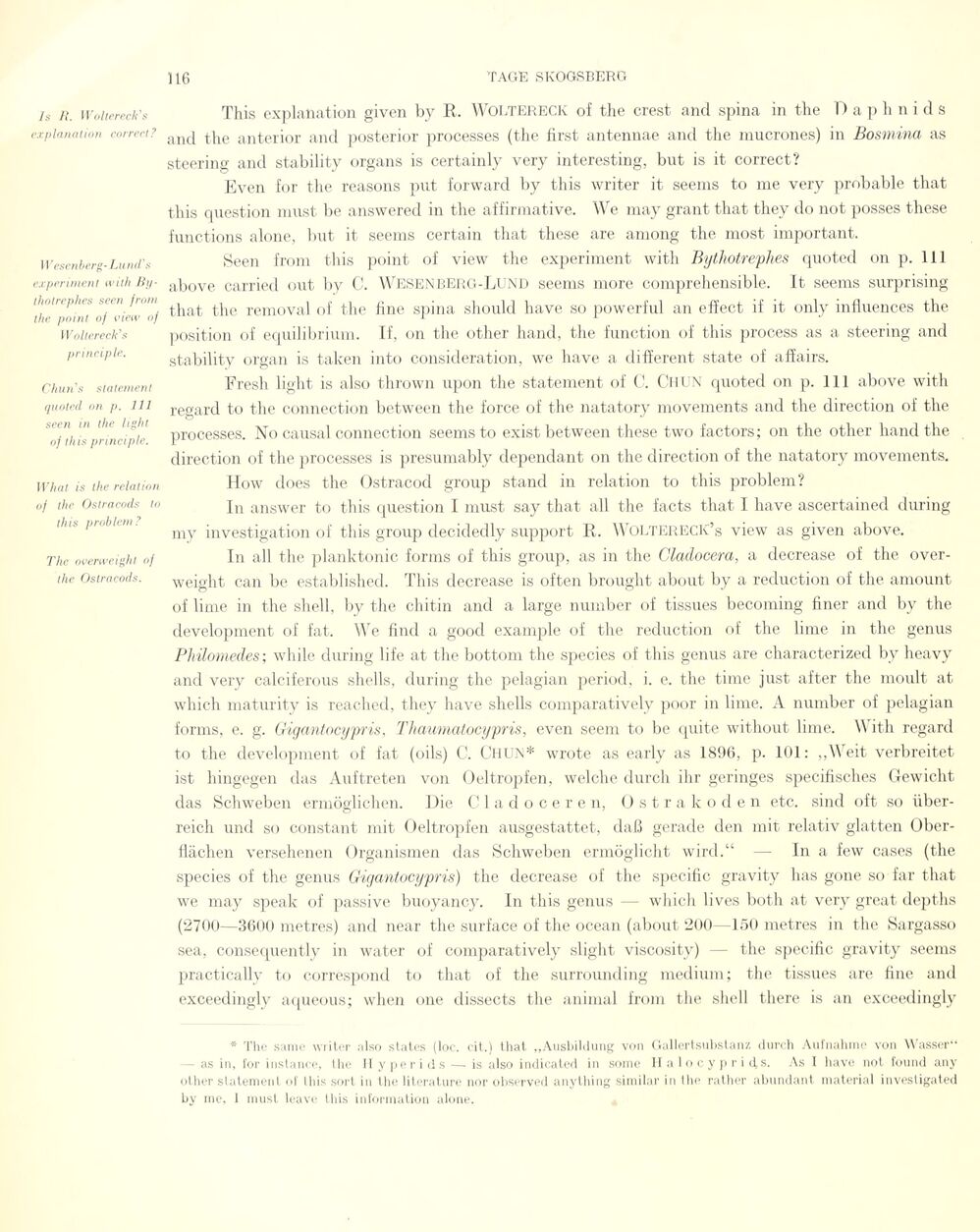
Full resolution (JPEG) - On this page / på denna sida - Sidor ...

<< prev. page << föreg. sida << >> nästa sida >> next page >>
Below is the raw OCR text
from the above scanned image.
Do you see an error? Proofread the page now!
Här nedan syns maskintolkade texten från faksimilbilden ovan.
Ser du något fel? Korrekturläs sidan nu!
This page has never been proofread. / Denna sida har aldrig korrekturlästs.
Is H. Woltereck’s
exploitation correct?
Wesenberg-Lund’s
experiment wilh
By-thotrephes seen front
the point of view of
Woltereck’s
principle.
Chun’s statement
quoted on p. 111
seen in the hght
of this principle.
What is the relation
of the Ostracods to
this problem?
The overweight of
the Ostracods.
This explanatiori given by R. WOLTERECK of the crest and spina in the Daphni d s
and the anterior and posterior processes (the lirst antennae and the mucrones) in Bosmina as
steering and stability organs is certainly very interesting, but is it correct?
Even for the reasons put forward by this writer it seems to me very probable that
this question must be answered in the affirmative. We may grant that they do not posses these
funetions alone, but it seems certain that these are among the most important.
Seen from this point of view the experiment with Bythotrephes quoted on p. 111
above carried out by C. Wesenberg-LUND seems more compréhensible. It seems surprising
that the removal of the fine spina should have so powerful an efïect if it only influences the
position of equilibrium. If, on the other hånd, the funetion of this process as a steering and
stability organ is taken into considération, we have a different state of affairs.
Fresh light is also thrown upon the statement of C. Chun quoted on p. 111 above with
regard to the connection between the force of the natatory movements and the direction of the
processes. No causal connection seems to exist between these two factors; on the other hånd the
direction of the processes is presumably dependant on the direction of the natatory movements.
How does the Ostracod gro up stand in relation to this problem?
In answer to this question I must say that all the facts that I have ascertained during
my investigation of this group decidedly support R. Woltereck’s view as given above.
In all the planktonic forms of this group, as in the Cladocera, a decrease of the
over-weight can be established. This decrease is often brought about by a réduction of the amount
of lime in the shell, by the chitin and a large number of tissues becoming finer and by the
development of fat. We find a good example of the réduction of the lime in the genus
Philomedes; while during life at the bottom the species of this genus are characterized by heavy
and very calciferous shells, during the pelagian period, i. e. the time just after the moult at
which maturity is reached, they have shells comparatively poor in lime. A number of pelagian
forms, e. g. Gigantocypris, Thaumatocypris, even seem to be quite without lime. With regard
to the development of fat (oils) C. CHUN* wrote as early as 1896, p. 101: „Weit verbreitet
ist hingegen das Auftreten von Oeltropfen, welche durch ihr geringes specifisches Gewicht
das Schweben ermöglichen. Die C 1 a docer en, O s trak oden etc. sind oft so
überreich und so constant mit Oeltropfen ausgestattet, daß gerade den mit relativ glatten
Oberflächen versehenen Organismen das Schweben ermöglicht wird.“ —■ In a few cases (the
species of the genus Gigantocypris) the decrease of the specific gravity has gone so far that
we may speak of passive buoyancy. In this genus — which lives both at very great depths
(2700—3600 metres) and near the surface of the ocean (about 200—150 metres in the Sargasso
sea, consequently in water of comparatively slight viscosity) — the specific gravity seems
practically to correspond to that of the surrounding medium; the tissues are fine and
exceedingly aqueous; when one dissects the animal from the shell there is an exceedingly
* The s:mu* w Oter also states (loc. cit.) that „Ausbildung von Gallertsubstanz durch Aufnahme von Wasser“
- as in, for instance, t lie Hy per ids — is also indicated in sonne Halocyprid,s. As I have not found any
other statement of this sort in the literature nor observet! anything similar in the rather abundant material investigated
by me, 1 must leavt* this information alone.
<< prev. page << föreg. sida << >> nästa sida >> next page >>